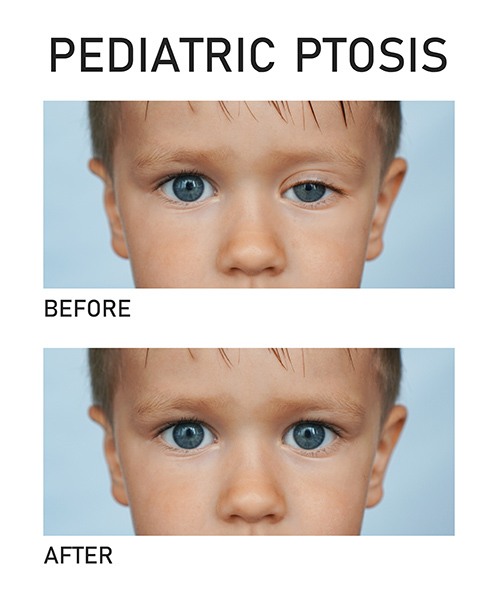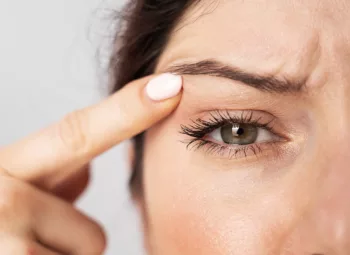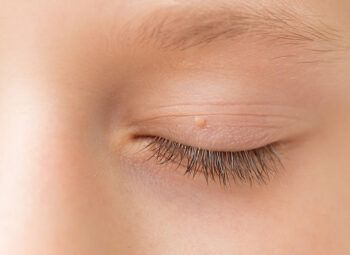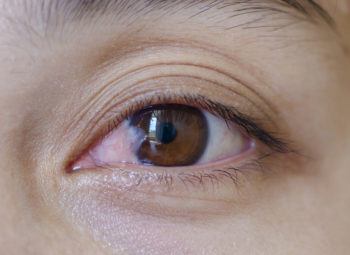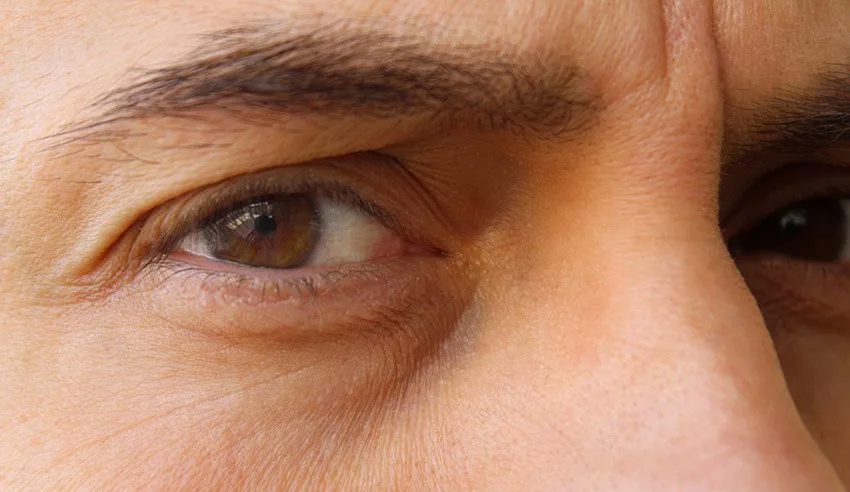
What to Expect After Having Ptosis Surgery for Upper Eyelid Drooping
Ptosis is a medical condition that causes the upper eye skin to droop over the eye. This condition can affect either one or both of the eyelids and is either developed at birth, or it can develop as you age.
Congenital ptosis in babies is most commonly caused by improper development of the levator muscle which is responsible for keeping your eyelid in place. Children with this drooping eyelid condition can also develop amblyopia (lazy eye). Involutional ptosis can develop as you age and is typically the result of the levator muscle becoming weak or damaged due to an injury.
While some patients who have drooping upper eyelid skin can feel insecure about how it affects their appearance, ptosis can also cause discomfort, and it can even interfere with your ability to see. The most common treatment for eyelid drooping is a cosmetic surgery called ptosis repair, or ptosis surgery.
If you are considering treatment, but want to learn more about what to expect after ptosis surgery, the ophthalmologists at NeoVision Eye Center are here to help. In this guide, we explain the procedure and outline the ptosis surgery recovery timeline and what to expect as your heal.
Ptosis Upper Eyelid Surgery
Your eye surgeon may suggest ptosis surgery if you experience discomfort or vision loss in one of both of your eyes due to droopy eyelids. Surgery to correct ptosis is a safe and effective treatment that is suitable for children as young as preschool age. This state-of-the-art cosmetic treatment, also known as blepharoplasty eyelid surgery, is a simple outpatient procedure that only requires local anesthesia or light sedation.
The exact procedure your eye surgeon will perform will vary depending on how severe your eyelids droop. Most commonly ptosis repair involves removing the excess drooping skin from above the eyelid. More severe cases of ptosis may also require your ophthalmologist to tighten the levator muscle with a simple stitch.
Your eye surgeon will then use dissolvable sutures to seal the incision line, and your body will immediately move into its natural recovery phase. With the excessive eyelid skin removed patients experience improvements to their vision, and many also report feeling more confident in their appearance.
Discuss your options with a certified eye surgeon!
Talk with Dr. Tandon today to determine if eyelid surgery is your child’s best option for dealing with ptosis or amblyopia.
Ptosis Surgery Recovery Timeline
While every patient’s healing timeline will be unique, patients can expect it to take up to three months to fully recover after undergoing ptosis surgery. Post-op recovery will happen in stages, and understanding what to expect during each stage can help ensure optimal results and a more comfortable healing process.
Immediately After Ptosis Surgery
As soon as ptosis surgery is completed, you may experience blurry vision due to the ointment used to ensure your eye remains well lubricated. The surgery area will need to be covered with a padded bandage for a minimum of 24 hours to protect your eye and help with swelling. As the anesthetic wears off it is common to experience some pain, but most patients report it to be tolerable and easily managed.
Adults will be able to return home the same day as surgery but you will need to arrange for someone to drive you home after, as driving is not permitted for the first day or two. Children are advised to stay in the hospital until the anesthesia wears off but can return home the same day.
Common Side Effects
- Eyelids may feel sore and tight
- Eyes may water, itch, or feel dry
- Light sensitivity
- Slight bruising and swelling
- Blurry vision for a few days
- Dry spots that may need lubrication
Your eye area is a sensitive part of the body, and your eyelid skin is quite thin and delicate. To ensure the best results and simplest recovery, it is imperative that you follow all of your doctor’s post-op instructions and attend your follow-up appointments.
The Days Following Ptosis Surgery
While you should expect minimal interruption to your daily routine in the days following surgery, you should plan on resting as much as possible. Typical swelling and bruising can be reduced by sleeping propped up for the first couple of days and by carefully placing an ice pack on the area with minimal pressure.
Within the first couple of days, it is common to feel soreness and slight discomfort that should be manageable with over-the-counter pain relievers. If you experience any very sharp pain, excessive bleeding, or vision loss not caused by bandages or lubricants call your eye surgeon immediately and seek emergency help.
Most patients are able to return to work or school within one to two days after ptosis treatment. However, you will need to refrain from any sort of manual labor or any heavy lifting for 1-2 weeks post-surgery.
The Do’s and Don’t of Ptosis Surgery Aftercare
- Do follow all aftercare instructions provided by your eye surgeon
- Do Avoid Smoking, swimming, heavy lifting, and other strenuous activities
- Do sleep sitting up for a few days
- Do wear sunglasses when outside
- Don’t wear contacts or makeup until your eye surgeon says it is okay
- Don’t rub your eyes
- Don’t use any blood-thinning medications until your eye surgeon says it is okay
For the first five days after surgery, it is important to keep your surgery site dry when showering or bathing. After five days, you can gently wash and pat your eyes dry with a clean cotton cloth to ensure the incision site remains sanitary.
The Weeks Following Ptosis Surgery
A few weeks after surgery, you will find it easier to move your eyes around and lift your eyelids up and down. Most patients begin to see noticeable improvements in bruising, swelling, and asymmetry around the eyes within 7-12 days post-treatment, particularly if you have followed all your surgeon’s post-surgical aftercare advice properly.
Along with avoiding any heavy lifting, it is recommended that patients refrain from wearing contact lenses or make-up for the first two weeks following ptosis surgery. Make sure to get approval from your doctor before returning to any of these activities.
For rare and extreme scenarios, call your surgeon if you experience any of the following:
- Severe pain in the eyes or fluid discharge
- Fever, vomiting, or diarrhea
- Prolonged vision loss
- Excessive bleeding
- Trauma anywhere near the surgical site
- Drooping of the same eyelid again
- Restricted eyelid movement
The Months Following Ptosis Surgery
In the months after your surgery, you will likely feel completely healed and back to normal, but it is important to continue to follow all your doctor’s post-op instructions. If your healing is on track, you will be able to discuss your results with your eye surgeon during your follow-up appointments. If you feel the eyelid positioning is irregular a follow-up procedure can be performed, but this is uncommon.
There are very few complications reported after ptosis surgery, and many can be treated with very minor adjustments. In rare cases, loss of lash hair is possible if the hair follicles are lost or damaged when the eyelid skin is removed.
Within three months most patients are fully recovered from ptosis surgery and commonly report being extremely satisfied with their results.
Learn More About Ptosis Treatment at NeoVision Eye Center
If you are considering correcting drooping eyelids with ptosis surgery for yourself or for a child, the highly-experienced eye surgeons at NeoVision Eye Center are here to help. Our team has over two decades of experience and has performed thousands of successful eye procedures to improve the vision, comfort, and appearance of our patients.
Contact our Union City office toll-free at 1-510-431-5511, or online for a free ptosis surgery consultation today.

